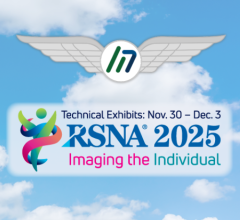
Quantivly's co-founders: Robert MacDougall (left) and Benoit Scherrer (right)
November 29, 2022 — Quantivly is highlighting new advances in its artificial intelligence (AI)-driven software for improving efficiency in medical imaging at the Radiological Society of North America (RSNA) meeting in Chicago November 27 to December 1. The company's technology will also be the subject of several scientific papers on improving MRI efficiency.
Despite its important role in diagnosing disease and guiding treatment, radiology is under severe economic pressure as reimbursement rates fall for many common scans. At the same time, procedure volume is climbing with the aging population, and the specialty is encountering staffing difficulties for both radiologists and radiologic technologists – adding urgency to the need to operate more efficiently.
A spin-off from Boston Children's Hospital, Quantivly started with the realization that much of the operational data already exists to improve radiology operations, but is disorganized and located in different siloes across a hospital. Quantivly solves this problem of "data liquidity" by extracting image metadata and radiology information system (RIS) messages on-the-fly, cleaning and harmonizing it with the company's Harmonization Engine to make data fully query-able, and building a new ontology that describes radiology operations.
Quantivly's platform is designed to help imaging facilities run more smoothly and delivers key insights to improve operational efficiency. The software goes beyond the manual measurement of key performance indicators (KPIs) to give leaders an automated 360° view of their operations, providing insights on parameters that previously were extremely difficult to measure.
Quantivly has an ambitious vision to build the "digital twin" for radiology operations, providing leaders with a new way to manage operations. Digital twins are virtual representations of existing physical systems that allow users to simulate real-world conditions – as well as to evaluate the impact of interventions in-silico, without the need for expensive and impractical changes, and without disrupting the clinical workflow of a healthcare facility.
"It's crazy how MRI machines cost up to $4 million and yet it's so hard to know how they are utilized. We started with the goal to clean and organize operational data from existing siloes, and make it useful for imaging providers. Beyond just unlocking data, we believe our digital twin vision and the ability to ask 'what if?' and simulate scenarios in software will radically reshape the way imaging facilities operate," said Benoit Scherrer, Chief Executive Officer at Quantivly.
Quantivly began shipping its platform in 2021, first focusing on analyzing MRI operations. The software tracks measures such as protocol duration, amount of time between patient scans, procedure repeat rates, and more. The platform is unique in its application of AI for radiology operations, not clinical diagnosis.
One of the sites that has been working with Quantivly is the University of California, San Francisco (UCSF).
"The last few years have seen the demand for imaging grow to unprecedented levels. More than ever, we need new analytical tools to understand how our practice operates at scale, and to help steward our resources to meet the needs of our patients. We're excited to partner with Quantivly to develop digital twins to optimally refine the way we work," said Christopher P. Hess, MD, PhD, Alexander Margulis Professor, Chair of the Department of Radiology and Biomedical Imaging at UCSF.
At RSNA 2022, Quantivly will show its progress in aggregating and harmonizing new data sources including the support for CT devices and scheduling information (RIS-HL7), allowing comparison of what happened with a scan (from DICOM image and metadata) to what was scheduled (from HL7). The company plans to continue the expansion of data sources and then extend toward its digital twin vision with a simulation engine in 2023-2024.
Quantivly's technology will also be the subject of several poster and scientific presentations at RSNA 2022:
- Data Driven Optimization and Monitoring of MR Scheduling
Poster presentation T5B-QI-8, Learning Center - QI DPS
12:45 pm to 1:15 pm Central time, Tuesday November 29
This presentation will analyze the true duration of MRI exams to identify the inefficiencies in scheduling and develop a more accurate analysis of the true duration of exams so adjustments can be made.
- Optimizing Scheduling of Abbreviated MRI for Hepatocellular Carcinoma Screening
8 am to 9 am Central time, Wednesday November 30
Scientific session W1-SSNPM03-1, South Hall Room S402
What's the optimal exam duration for an abbreviated MRI scan for hepatocellular carcinoma screening? In determining the exact duration, radiology departments could perform several additional scans per day.
- A New Era of Quality Improvement: Creating a Digital Twin of the Radiology Department to Drive Efficiencies in Operations and Workflow
12:45 pm to 1:15 pm Central time, Thursday December 1
Poster presentation R5B-QI-2, Learning Center - QI DPS
The concept of the digital twin for radiology operations will be discussed, specifically as it applies to the achievable exam slot duration for a commonly performed MRI exam.
For more information: https://www.quantivly.com


 November 26, 2025
November 26, 2025 









